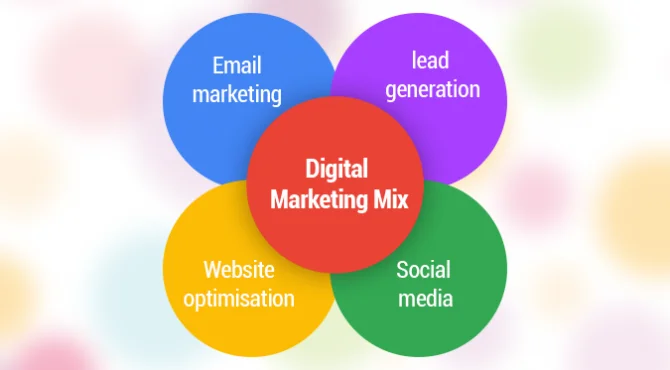The world has changed. Consumers don't wait for you to find them; they research, compare, and decide. They research before buying, read reviews, and trust a friend's opinion more than an advertisement.
In this new environment, how do you ensure your business not only survives, but thrives? The answer lies in a flexible, customer-centric strategy, and the Marketing Mix remains the perfect foundation for building it. But beware, the traditional concept has evolved.
In this post, we'll not only tell you what the famous "4Ps" are, but we'll also show you how to apply them today to connect with your audience and achieve your goals.
What is the Marketing Mix?
Think of the Marketing Mix as your business's secret sauce. It's the key ingredients (product, price, distribution, and promotion) that, when combined correctly, allow you to:
-
Attract customers: Reach the right people with the right message.
-
Position your brand: Create a unique perception of value in the minds of your consumers.
-
Making strategic decisions: Understanding what to adjust to respond to changing market needs.
It's not about following a rigid formula, but rather adapting each element to best serve your target audience.
The 4 P's of the marketing mix that bring your strategy to life
Each of the "P"s is a lever you can pull to optimize your strategy. Here's how they work in the current context.
1. Product (or Service)
The product isn't just what you sell; it's what your customer really needs. It's the solution to their problem, the answer to their desire.
Think about these key questions:
-
What value do you provide? What do you need to solve for your audience?
-
What is the customer experience like? From your website's usability to after-sales service, every detail counts in creating an unforgettable experience.
-
Is your brand memorable? Beyond technical features, what emotions or values does your product convey?
In the digital age, the ideal product is designed with a very specific customer profile in mind, often through personalization and co-creation.
Pro Tip: Share your experience and write a review for local business to help others make informed choices while supporting small businesses in your community.
2. Price
Price is a message. It not only defines your revenue, but also communicates the value and quality of your brand.
Before setting a number, consider:
-
Perceived value: How much is your customer willing to pay for the solution you offer?
-
Costs: Including not only production costs, but also marketing, distribution, and service costs.
-
The Competition: What pricing strategies do your direct competitors have?
Today, pricing is dynamic. Pricing strategies based on demand or user history are more effective than fixed pricing.
3. Distribution (Placement)
How and where does your customer encounter your product? Distribution defines the channels you use to reach your audience.
Think beyond physical points of sale:
-
E-commerce and online stores: Is your purchasing process intuitive, fast, and secure?
-
Social Media: Do you use Instagram Shopping, Facebook catalogs, or TikTok to help your customers discover and purchase from you without leaving the platform?
-
Marketplaces: Does it make sense to sell on Amazon, Etsy, or other platforms that already appeal to your audience?
The key is to be where your customers are, making the purchasing process as easy as possible.
4. Promotion
Promotion is how you communicate the value of your product. But traditional advertising is no longer enough.
A modern promotion strategy is based on a combination of:
-
Content Marketing: Blogs, videos, and podcasts that educate and entertain your audience.
-
Digital advertising: Precisely targeted social media campaigns (Facebook Ads, Instagram Ads) and Google Ads.
-
Digital PR: Collaborations with influencers and media outlets in your industry to build trust.
-
Email Marketing: Creating a loyal community through personalized newsletters.
The goal is not just to sell, but to build a lasting relationship.
Beyond the 4 Ps: The Evolution to the Customer
The original marketing mix has evolved with the rise of the customer. It has transformed from a product-centric model to a people-centric one, giving rise to concepts such as Lauterborn's 4 Cs :
-
Customer (Customer needs and wants): Instead of the Product, the strategy revolves around the customer's needs.
-
Cost to satisfy: Price is replaced by the total cost of the experience for the customer, including time and effort.
-
Convenience to buy: Distribution focuses on ease of purchase, both online and offline.
-
Communication: Promotion becomes a two-way dialogue, not a sales monologue.
This holistic view is what truly enables your business to succeed today.
Ready to create your own winning marketing mix?
Whether your business is large or small, digital or physical, the Marketing Mix is the tool you need to build a solid plan.
-
Define your ideal client: Who is your audience? What problems do they have?
-
Tailor your offering: Make sure your product (and its perceived value) solves their problems.
-
Choose your channels: Where and how will you reach your audience most effectively?
-
Communicate with purpose: What story do you want to tell? What value do you want to convey?
At City Local 101, we are experts in creating marketing mix strategies that connect with your audience and help you achieve your business goals. Do you have a project in mind? Discover the potential of our marketing consultancy.






